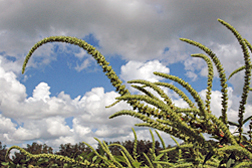Washington, DC, USA
November 18, 2013

Palmer amaranth is an aggressive weed of the south that can grow at the rate of two inches a day and outcompete many crops. Photo courtesy of Joseph LaForest, University of Georgia, Bugwood.org.
A naturally occurring fungus may prove useful in the fight against Palmer amaranth, an aggressive southern weed that can grow at the rate of two inches a day and outcompete corn, cotton, soybean and other crops for resources, potentially reducing their yields.
To make matters worse, some biotypes of the weed have become resistant to glyphostate herbicides. As a possible alternative, U.S. Department of Agriculture (USDA) scientists in Stoneville, Miss., are exploring ways to formulate Myrothecium verrucaria, a fungus which attacks Palmer amaranth's leaf and stem tissues, causing wilt, necrotic lesions, loss of chlorophyll, and other disease symptoms that can kill young plants and weaken older ones.

ARS plant pathologist Doug Boyette has found a fungus that can be grown in a fermentor which may be able to control Palmer amaranth, a weed that is becoming resistant to some herbicides.
Studies by Robert Hoagland, Doug Boyette and others at the Jamie Whitten Delta States Research Center operated by USDA's Agricultural Research Service (ARS) in Stoneville, indicate Myrothecium can wreak similar havoc on biotypes of Palmer amaranth that resist glyphosate and other herbicides such as triazines.
To test Myrothecium's infectivity, the researchers used a filamentous growth stage known as mycelium and sprayed a special formulation of it onto two batches of four-week-old Palmer amaranth seedlings: those with glyphosate resistance and those without. They repeated the same procedure with six-week-old plants. All groups were visually checked for symptoms over the experiment's seven-day (168-hour) period and then weighed for reductions in shoot growth.
Seedlings were most susceptible, with all plants exposed to a full-strength application of the fungus showing disease symptoms. By 48 to 72 hours, nearly 100 percent had died. In six-week-old plants, symptoms progressed more slowly, but there was no significant difference in injury between glyphosate-resistant and glyphosate-susceptible plants. Both groups showed disease symptoms, most notably chlorosis, some necrosis, and stunted growth.
The findings, published in Allelopathy Journal, mark the first report of Myrothecium's bioherbicidal activity against a weed species with glyphosate resistance.
Read more about this research in the November/December 2013 issue of Agricultural Research magazine. ARS is USDA's principal intramural scientific research agency.
Hongo podría ayudar a control una maleza - Los científicos del ARS dicen que un hongo natural podría ser útil en la lucha contra Amaranthus palmeri, la cual es una maleza invasora que puede consumir los recursos naturales necesitados por los cultivos
Un hongo natural podría ser útil en la lucha contra Amaranthus palmeri, la cual es una maleza invasora que puede crecer hasta dos pulgadas por día y puede consumir los recursos naturales necesitados por los cultivos de maíz, algodón y soya, de este modo disminuyendo sus rendimientos.
Para colmo de desgracias, algunos biotipos de la maleza han desarrollado resistencia al herbicida glifosato. Como otra opción, científicos del Servicio de Investigación Agrícola (ARS) en Stoneville, Misisipi, están explorando maneras de formular Myrothecium verrucaria, el cual es un hongo que ataque las hojas y el tallo de A. palmeri, causando la marchitez, las lesiones necróticas, la pérdida de clorofila, y otros síntomas de enfermedad que pueden matar las plantas jóvenes y debilitar las plantas más maduras.
Estudios por Robert Hoagland, Doug Boyette y otros científicos en el Centro Jamie Whitten de Investigación en los Estados del Delta mantenido por el ARS en Stoneville indican que Myrothecium puede causar daños en biotipos de A. palmeri que tienen resistencia al glifosato y otros herbicidas tales como las triazinas.
Para probar la infectividad de Myrothecium, los investigadores usaron una etapa de crecimiento en la cual el hongo forma filamentos. Los científicos rociaron una formulación especial de esta forma del hongo en dos grupos de plantas de A. palmeri que tuvieron cuatro semanas de edad. Algunas de las plantas tuvieron resistencia al glifosato, pero otras no tuvieron resistencia. Todas las plantas se observaron para detectar síntomas durante un período de 168 horas, y luego las plantas se pesaron para detectar reducciones en el crecimiento de brotes.
Las plantas más jóvenes fueron las más propensas a enfermedad, y todas las plantas que recibieron la máxima aplicación del hongo tuvieron síntomas de enfermedad. Después de 48 a 72 horas, casi el 100 por ciento de estos plantas murieron. En las plantas que tuvieron una edad de seis semanas, los síntomas desarrollaron más lentamente, pero no fue una diferencia significativa en daños entre las plantas con resistencia al glifosato y ellas sin resistencia. Ambos grupos demostraron síntomas de enfermedad, incluyendo clorosis, un poco de necrosis, y una reducción en crecimiento.
Estos hallazgos han sido publicados en 'Allelopathy Journal' (Revista de Alelopatía), y fueron el primer informe sobre actividad bioherbicidal contra una especie de maleza que tiene resistencia al glifosato.
Lea más sobre esta investigación en la revista 'Agricultural Research' de noviembre-diciembre del 2013. ARS es la agencia principal de investigaciones científicas del Departamento de Agricultura de EE.UU.